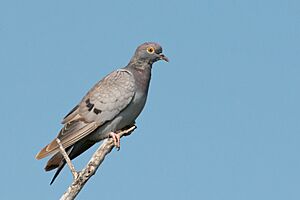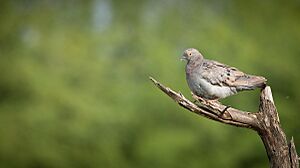Yellow-eyed pigeon facts for kids
Quick facts for kids Yellow-eyed pigeon |
|
|---|---|
 |
|
| Columba eversmanni from Tal Chapar Wildlife Sanctuary, Rajasthan, India | |
| Conservation status | |
| Scientific classification | |
| Genus: |
Columba
|
| Species: |
eversmanni
|
The yellow-eyed pigeon is also known as the pale-backed pigeon or yellow-eyed dove. Its scientific name is Columba eversmanni. This bird is part of the Columbidae family, which includes all doves and pigeons. These pigeons breed in countries like southern Kazakhstan, Uzbekistan, Turkmenistan, Tajikistan, Kyrgyzstan, Afghanistan, north-east Iran, and a small part of north-west China.
When winter comes, they fly south to places like north-east Pakistan, Jammu and Kashmir, and parts of Rajasthan in India. Sadly, the number of yellow-eyed pigeons has gone down a lot over the years. This is mainly because of hunting. Because of this, the International Union for Conservation of Nature has listed them as a "vulnerable" animal, meaning they are at risk of disappearing.
A French bird expert named Charles Lucien Bonaparte first described this pigeon in 1856. The pigeon's scientific name, eversmanni, honors a German biologist and explorer named Eduard Friedrich Eversmann. He studied many plants and animals in the steppes of Russia.
Contents
What Does the Yellow-Eyed Pigeon Look Like?
The yellow-eyed pigeon is a medium-sized bird. It grows to be about 30 centimeters (12 inches) long. It usually weighs between 183 and 234 grams (6.5 to 8.2 ounces).
Most of its body is grey. Its upper parts have a slightly brownish color. The top of its head, throat, and chest have a pretty pinkish-purple shine. You can see a black bar on its wing and a dark band on its tail. The lower part of its back, its rump, and the underside of its wings are white or light grey.
Around its eye, there's a patch of yellowish skin. Its eye itself is yellow, and its beak is also yellowish. Its feet are pink.
This pigeon can sometimes be mistaken for the rock dove (C. livia). However, rock doves have clearer wing bars and tail bands. The hill pigeon (C. rupestris) also looks similar, but it has a white band on its tail just before the black tip. The yellow-eyed pigeon is usually a quiet bird. But during the time they lay eggs, they sometimes make a soft "oo-oo-oo" sound.
Where Do Yellow-Eyed Pigeons Live?
Yellow-eyed pigeons breed in southern Kazakhstan, Uzbekistan, Turkmenistan, Tajikistan, Kyrgyzstan, Afghanistan, north-east Iran, and the far north-west of China. When autumn arrives, they migrate south. They spend the winter in Pakistan, north-western India, and parts of north-western China, like the provinces of Xinjiang and Gansu.
In their breeding areas, they live in steppes and other low-lying places. This includes dry or semi-dry areas. In their winter homes, you can find them in farm areas, fruit orchards, and open countryside with scattered trees. They especially like places where mulberry trees grow.
Yellow-Eyed Pigeon Life and Habits
Yellow-eyed pigeons mostly eat seeds, grains, and berries. They usually look for food on the ground. Sometimes, they will pick fruits directly from tree branches.
They start their migration south in October and November. In winter, they gather in flocks and rest in trees. Long ago, these flocks had thousands of birds. But now, their numbers have shrunk. Flocks often have only a few dozen birds, and rarely more than a few hundred.
They return to their breeding areas in April. Nesting happens during the late spring and summer. They build their nests in holes in cliffs, hollow trees, or old, ruined buildings. The female pigeon lays two white eggs on a platform made of sticks.
Why Are Yellow-Eyed Pigeons Vulnerable?
The number of yellow-eyed pigeons used to be very high, but it has gone down a lot over the years. The biggest danger to these birds is hunting. People hunt them in both their breeding areas and their winter homes. We don't know exactly how fast their numbers are still dropping, but it might be continuing. Because of this, the International Union for Conservation of Nature has decided that the yellow-eyed pigeon is a "vulnerable" species. This means they need our help to survive.
Images for kids




